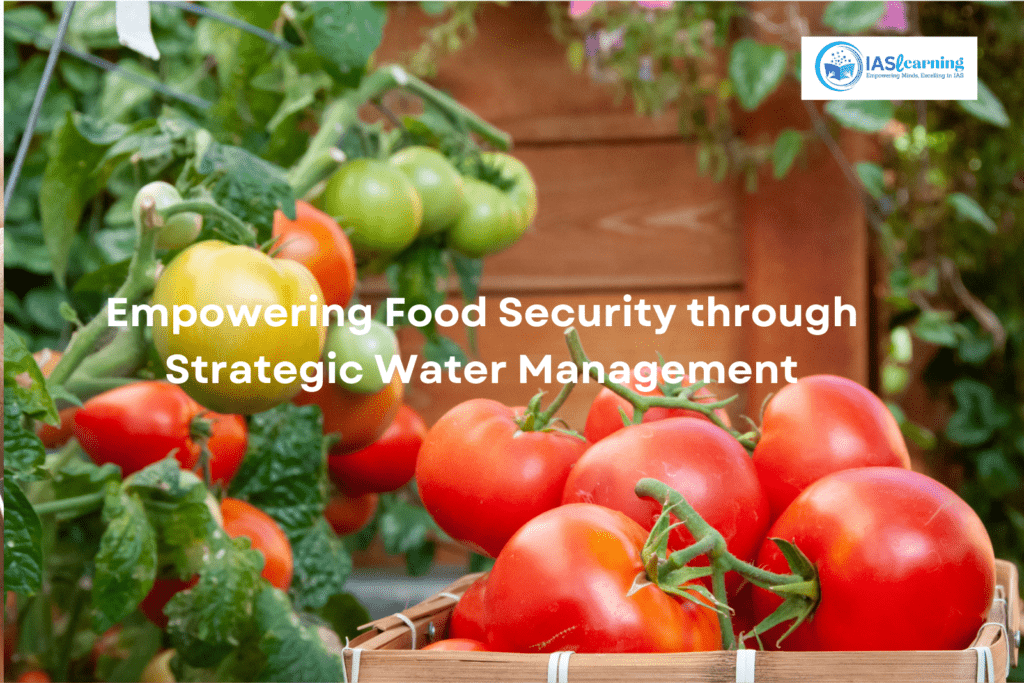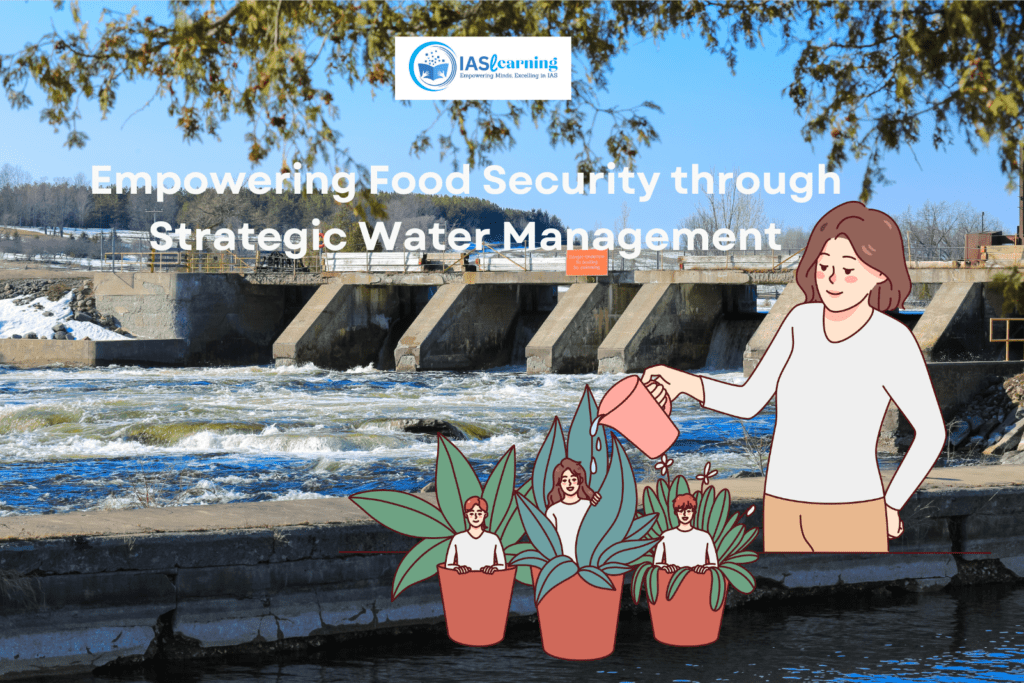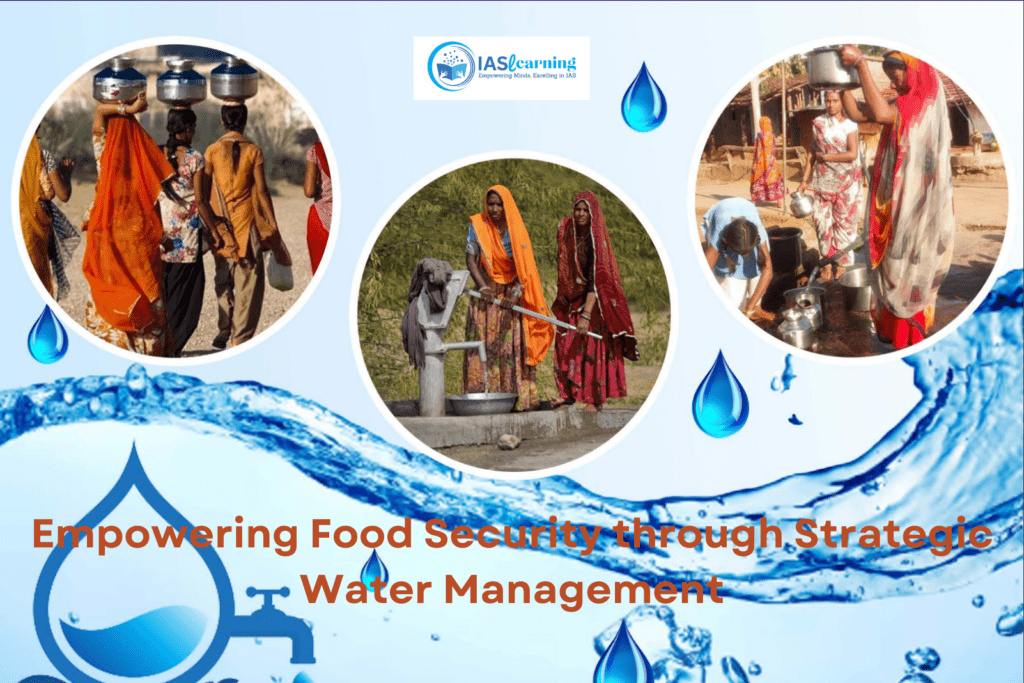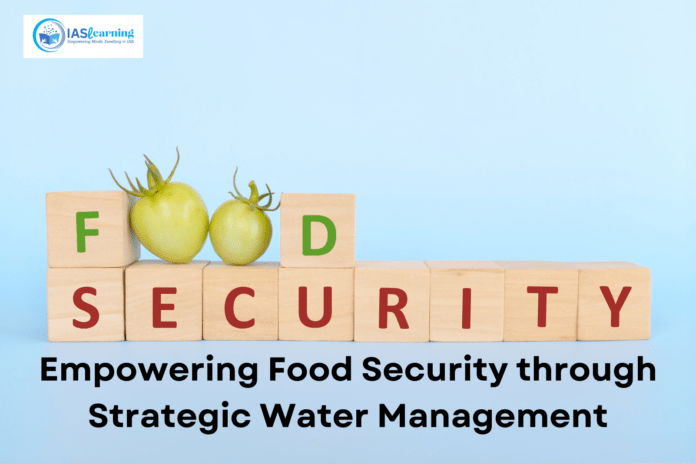Introduction to Food Security through Strategic Water Management
The sustainability of the global food system is under threat due to the increasing demand on vital natural resources, notably land and water. In the near future, effective water management will be a critical factor in ensuring water security and making significant strides towards achieving the Sustainable Development Goals (SDGs).

Need for effective water management and conservation
- Critical Component of Agriculture: Water is an indispensable element in agricultural production and ensuring global food security.
- Heavy Water Usage in Agriculture: Agriculture stands as the largest consumer of water resources worldwide, accounting for more than 70% of both surface and groundwater withdrawals, mainly for irrigation purposes.
- Rainfed vs. Irrigated Farming: Rainfed farming, despite using only 80% of cultivated land, generates 60% of the world’s food. In contrast, irrigated farming, utilizing just 20% of the land, contributes 40% of global food output.
- Water Allocation in India: In India, the agricultural sector consumes a substantial 80-90% of the total water consumption, with half of the agricultural land still relying on rainfed farming.
- Enhanced Agricultural Yields: Irrigation significantly boosts agricultural yields, often increasing them by 100% to 400%.
- Irrigated Agriculture in India: In India, net irrigated agriculture spans 75456 thousand hectares, while gross irrigated agriculture covers 112229 thousand hectares.
- Water Supply in India: India primarily relies on annual precipitation, including snowfall, as its main water source. Despite its large population, India possesses only 4% of the world’s water resources, making it one of the most water-stressed countries globally.
- Growing Food Demand: With a projected larger population by 2050, agriculture will need to produce over 50% more food, livestock feed, and biofuel compared to 2012 to meet global demand and work toward achieving ‘zero hunger.’

Government Initiatives
- Sahi Fasal Campaign: A program focused on promoting smart and sustainable farming practices to optimize crop production while conserving water resources.
- River Development and Ganga Rejuvenation: Efforts to rejuvenate and restore rivers, with a particular focus on the Ganga River, to improve water quality and availability.
- National Water Mission: A national-level initiative designed to address water-related challenges, promote efficient water use, and ensure sustainable water management practices across the country.
- Pradhan Mantri Krishi Sinchayee Yojana (PMKSY)-Har Khet Ko Pani (HKKP): A scheme dedicated to ensuring water availability for every farm, enhancing irrigation efficiency, and promoting responsible water use in agriculture.
- Per Drop More Crop: A program aimed at encouraging farmers to adopt efficient irrigation techniques and technologies to maximize agricultural productivity with minimal water resources.
- Atal Mission for Rejuvenation and Urban Transformation (AMRUT): An urban-focused initiative that includes water supply and wastewater management projects to ensure efficient water use in urban areas.
- Repair, Renovation, and Restoration (RRR) of Water Bodies Scheme: A scheme dedicated to the repair and restoration of traditional water bodies such as ponds, lakes, and reservoirs to enhance water storage and availability.
Water Conservation Strategies in Agriculture
- Pradhan Mantri Krishi Sinchayee Yojana (PMKSY):
- Launched in 2015, PMKSY is a centrally sponsored scheme with a budget of Rs 93,068 crores for the years 2021-26.
- This comprehensive scheme offers an end-to-end solution for irrigation, encompassing source generation, distribution, administration, field application, and extension efforts.
- PMKSY was formed by merging several existing schemes, including the Accelerated Irrigation Benefit Programme (AIBP) by the Ministry of Jal Shakti, the Integrated Watershed Management Programme (IWMP) by the Department of Land Resources, and On Farm Water Management (OFWM) by the Department of Agriculture and Cooperation.
- Per Drop More Crop (PDMC):
- PDMC was launched in 2015 as a part of PMKSY and is currently implemented under the Rashtriya Krishi Vikas Yojana (RKVY) from 2022-23.
- It focuses on promoting micro-irrigation technologies such as sprinkler and drip irrigation systems.
- The Government of India offers subsidies through this scheme to farmers, with a subsidy rate of 45% for other farmers and 55% for small and marginal farmers, based on the suggested unit cost.
- Sahi Fasal Campaign:
- The Sahi Fasal campaign is a component of a broader water conservation initiative.
- The “Sahi Fasal” Campaign is an integral part of the National Water Mission, initiated by the Ministry of Jal Shakti in 2019. This program aims to motivate farmers in water-stressed regions to cultivate crops that offer multiple benefits:
- Healthy and Nutrient-Dense: The campaign encourages the cultivation of crops that are not only healthy and nutrient-rich but also meet the dietary needs of the population.
- Economically Rewarding: The chosen crops are economically rewarding, ensuring a sustainable income for farmers.
- Agro-Climatic Compatibility: The selected crops are compatible with the region’s agro-climatic and hydrological conditions, ensuring successful growth and minimal water usage.
- Environmentally Responsible: The Sahi Fasal program emphasizes environmentally responsible farming practices that reduce the ecological impact of agriculture.

Way Forward
- nter-State Cooperation: As water is a state subject in India, it is crucial to foster cooperation among states. Collaborative efforts are necessary to implement measures for resource augmentation, conservation, and effective management. Joint initiatives and agreements between neighboring states can help optimize water usage, particularly in regions that share water resources.
- Ecosystem Services: Recognizing the ecological benefits provided by healthy ecosystems is essential. Implementing policies and practices that safeguard ecosystems, such as forests, wetlands, and watersheds, can contribute to improved water quality and availability. Ecosystem-based approaches should be integrated into water resource management strategies.
- Incentives for Optimal Water Use: To encourage responsible water management, incentives should be introduced for farmers and industries that adopt water-efficient practices and technologies. Financial incentives, subsidies, and rewards for water-saving innovations can motivate stakeholders to use water more efficiently.
- Awareness and Education: Raising awareness among the general public and stakeholders about the importance of water conservation and sustainable water management is critical. Education campaigns and training programs can help disseminate knowledge about water-saving practices and the benefits of responsible water use.
- Technological Solutions: Embracing technology can play a significant role in water management. Implementing smart irrigation systems, remote sensing technologies, and data analytics can optimize water usage in agriculture and other sectors.
- Research and Innovation: Investment in research and innovation is essential to develop new and efficient water management techniques. Collaboration between research institutions, government agencies, and private sector entities can lead to breakthroughs in water conservation and management.
- Legislation and Policy: Continual review and enhancement of water-related legislation and policies are crucial. Policy frameworks should be adapted to changing environmental and demographic conditions while considering sustainability and equity.
- Community Engagement: Engaging local communities in water management decisions and initiatives is vital. Local knowledge and community-driven efforts can contribute to effective water conservation and sustainable resource use.
Conclusion
Addressing water-related challenges in India requires a multifaceted approach that involves cooperation among states, the recognition of ecosystem services, incentives for optimal water use, awareness campaigns, technological innovation, research, policy adaptation, and community involvement. A comprehensive and collaborative strategy is essential to ensure the sustainable management of India’s precious water resources.




